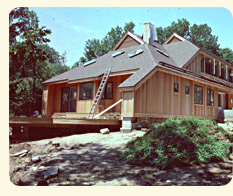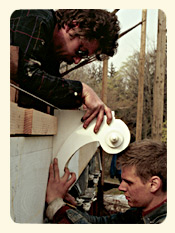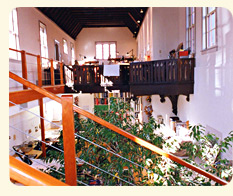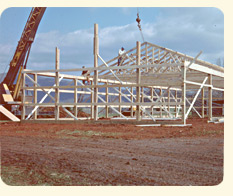
HISTORY – page 2
 The red-hot real estate market of the 80s allowed Scott to build custom
homes for various builders in the area. He also continued
to repair and restore old homes, as well as doing the usual remodeling
work that comes along in a suburban village.
The red-hot real estate market of the 80s allowed Scott to build custom
homes for various builders in the area. He also continued
to repair and restore old homes, as well as doing the usual remodeling
work that comes along in a suburban village.
 The late 80s included two highlights. The first was a porch restoration
at the Armour-Stiner Octagon House, a National Trust property which had
been deeded to restortation architect Joseph Pell Lombardi. The project
was Scott’s first exposure to the rigors of architectural forensics,
and it afforded a window into the rarefied world of museum-quality restoration.
The late 80s included two highlights. The first was a porch restoration
at the Armour-Stiner Octagon House, a National Trust property which had
been deeded to restortation architect Joseph Pell Lombardi. The project
was Scott’s first exposure to the rigors of architectural forensics,
and it afforded a window into the rarefied world of museum-quality restoration.
 The second highlight was the conversion of a 1920’s music hall to
an architectural studio for Stephen Tilly. The project began by removing
dead raccoons which had expired in the bowels of the building during it’s
intervening use as a warehouse. A year later the final coat of varnish
was applied to the glowing fir trim that delineates Tilly’s whimsical
design. Today the “Dobbs Ferry Playhouse” is recognized as
an outstanding example of adaptive re-use.
The second highlight was the conversion of a 1920’s music hall to
an architectural studio for Stephen Tilly. The project began by removing
dead raccoons which had expired in the bowels of the building during it’s
intervening use as a warehouse. A year later the final coat of varnish
was applied to the glowing fir trim that delineates Tilly’s whimsical
design. Today the “Dobbs Ferry Playhouse” is recognized as
an outstanding example of adaptive re-use.
 In 1991 Scott relocated to the rural village of Sperryville, Virginia,
at the foot of the Blue Ridge Mountains. The move required adaptation
to a very different social, economic, and architectural environment. Many
of Scott’s new clients were weekenders with their primary residences
in Washington, DC, so communication by e-mail became increasingly important.
Estate development, including oversight of roads, gardens, and septic
facilities became an important part of the work mix. Barn building opportunities
also presented themselves in the new rural environment.
In 1991 Scott relocated to the rural village of Sperryville, Virginia,
at the foot of the Blue Ridge Mountains. The move required adaptation
to a very different social, economic, and architectural environment. Many
of Scott’s new clients were weekenders with their primary residences
in Washington, DC, so communication by e-mail became increasingly important.
Estate development, including oversight of roads, gardens, and septic
facilities became an important part of the work mix. Barn building opportunities
also presented themselves in the new rural environment.
back to top